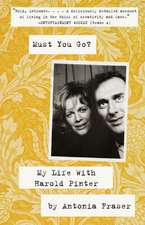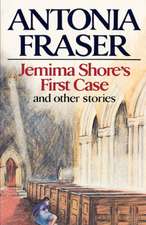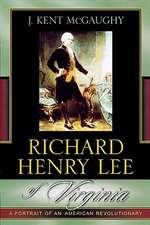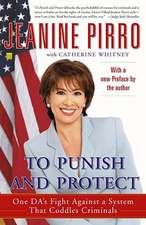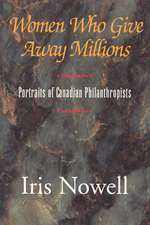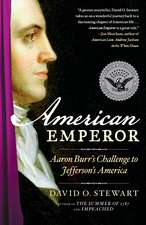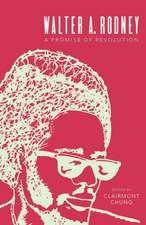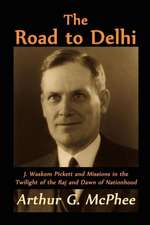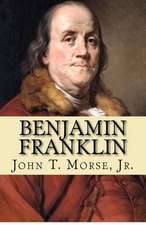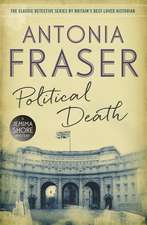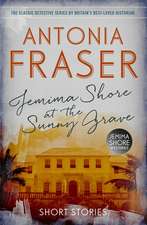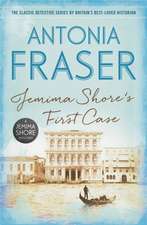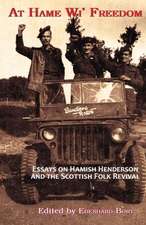Mary Queen of Scots
Autor Antonia Fraseren Limba Engleză Paperback – 31 aug 1993
She was the quintessential queen: statuesque, regal, dazzlingly beautiful. Her royal birth gave her claim to the thrones of two nations; her marriage to the young French dauphin promised to place a third glorious crown on her noble head.
Instead, Mary Stuart became the victim of her own impulsive heart, scandalizing her world with a foolish passion that would lead to abduction, rape and even murder. Betrayed by those she most trusted, she would be lured into a deadly game of power, only to lose to her envious and unforgiving cousin, Elizabeth I.
Here is her story, a queen who lost a throne for love, a monarch pampered and adored even as she was led to her beheading, the unforgettable woman who became a legend for all time.
Preț: 123.74 lei
Nou
Puncte Express: 186
Preț estimativ în valută:
23.68€ • 24.63$ • 19.55£
23.68€ • 24.63$ • 19.55£
Carte disponibilă
Livrare economică 24 martie-07 aprilie
Preluare comenzi: 021 569.72.76
Specificații
ISBN-13: 9780385311298
ISBN-10: 038531129X
Pagini: 640
Dimensiuni: 155 x 231 x 38 mm
Greutate: 0.64 kg
Editura: DELTA
ISBN-10: 038531129X
Pagini: 640
Dimensiuni: 155 x 231 x 38 mm
Greutate: 0.64 kg
Editura: DELTA
Notă biografică
Since 1969 Antonia Fraser has written many acclaimed historical works which have been international bestsellers and is the recipient of many literary awards, including the James Tait Black Memorial Prize. These include the biographies Cromwell: Our Chief of Men and King Charles II and the history Faith and Treason: The Story of the Gunpowder Plot. Three highly praised books focus on women in history: The Weaker Vessel: Women’s Lot in Seventeenth-Century England, The Warrior Queens, and The Six Wives of Henry VIII. Her most recent book was Marie Antoinette. She is editor of the series Kings and Queens of England. Antonia Fraser is married to the playwright Harold Pinter and lives in London.
Extras
All Men Lamented
'All men lamented that the realm was left without a male to succeed.'
-- John Knox
The winter of 1542 was marked by tempestuous weather throughout the British Isles: in the north, on the borders of Scotland and England, there were heavy snow-falls in December and frost so savage that by January the ships were frozen into the harbour at Newcastle. These stark conditions found a bleak parallel in the political climate which then prevailed between the two countries. Scotland as a nation groaned under the humiliation of a recent defeat at English hands at the battle of Solway Moss. As a result of the battle, the Scottish nobility which had barely recovered from the defeat of Flodden a generation before, were stricken yet again by the deaths of their leaders in their prime; of chose who survived, many prominent members were prisoners in English hands, while the rest met the experience of defeat by quarrelling among themselves, showing their strongest loyalty to the principle of self-aggrandizement, rather than to the troubled monarchy. The Scottish national Church, although still officially Catholic for the next seventeen years, was already torn between chose who wished to reform its manifold abuses from within, and those who wished to follow England's example, by breaking away root and branch from the tree of Rome. The king of this divided country, James V, having led his people to defeat, lay dying with his face to the wall, the victim in this as much of his own passionate nature, as of the circumstances which had conspired against him. When James died on 14 December 1542, the most stalwart prince might have shrunk from the Herculean task of succeeding him. But his actual successor was a weakly female child born only six days before, his daughter Mary, the new queen of Scotland.
James V, the last adult male king of Scotland for nearly fifty years, has been treated kindly by contemporary historians, who look back to his reign with nostalgia across the turbulence of that of his daughter. He has been credited with the qualities of King Arthur, whereas on balance his character seems to have been more like that of Sir Lancelot. Since his physical description, 'of midway stature', bluish grey eyes, sandy hair, weak mouth and chin, does not justify the general reputation he enjoyed among his contemporaries for good looks, he clearly possessed an animal magnetism, impossible for another century to understand through pictures. This, and his health, seems to have been his chief physical legacy to his daughter, since in all other respects, starting with her height and athletic carriage, the features and build of Mary Queen of Scots are far easier to trace among her physically magnificent Guise uncles, than in her Stewart forbears. Ronsard described him as having 'le regard vigoureux': James certainly possessed the cyclical high spirits and gaiety of the Stewarts - another quality which he handed on to his daughter - and the ability to fire the imagination of his subjects, an attribute generally described in monarchs as possessing the common touch. Unfortunately there is no doubt as to the reverse side of this golden coin: the evidence of the debauchery of James V is unanimous. 'Most vicious we shall call him,' wrote Knox with relish, relating how he spared neither man's wife nor maiden, no more after his marriage than he did before.
James inherited a kingdom bankrupted by his mother Margaret Tudor and her second husband, the earl of Angus; unfortunately his various efforts to search about him for new sources of income brought further troubles in their train. Even his prolonged search for a wealthy foreign bride set his feet firmly on the path of a foreign policy which proved in the final analysis to be disastrous. In view of the predatory attitude of his uncle, Henry VIII, towards Scotland, James determined upon the traditional Scottish alliance with the French king, in order to bolster himself with French aid against any possible English claims of suzerainty. Rightly or wrongly, James viewed Henry's offer of his daughter Mary Tudor as a bride, as a further effort on the part of his uncle to envelop Scotland in his bear's hug. At one point James even dangled after the young Catherine de Medicis, niece of the Pope, lured by the thought of her magnificent inheritance. The results of such a union, between Mary Stuart's father and the woman who was later to be her mother-in-law, provide an interesting avenue of historical speculation; in fact the match was doubly vetoed, by the Pope's reluctance to see his niece set off for the far land of Scotland, and by Henry VIII's anger at the idea of such a powerful match for his nephew. James's mother had been the elder of the two daughters of Henry VII; later this share of Tudor blood was to play a vital part in shaping the life story of James's daughter Mary; the deaths of two out of the three surviving children of Henry VIII meant that by the time Mary was sixteen she was next in line to the English throne after her cousin Queen Elizabeth. But in the 1530s, at the time of James V's marriage projects, these coming events had not yet cast their shadow. It was Henry VIII, in the fulness of his manhood, and with two children to his credit already branching out of the Tudor family tree, who seemed blessed with heirs. His nephew James on the other hand singularly lacked them.
The position of the Stewart monarchs in the fifteenth and sixteenth centuries was peculiarly perilous in dynastic terms, for a number of reasons. In the first place chance had resulted in a total of seven royal minorities - there had been no adult succession since the fourteenth century - which had an inevitable effect of weakening the power of the crown and increasing that of the nobility. Secondly, the Stewarts had a special reason for needing to separate themselves from the nobility, and raise themselves above it into a cohesive royal family, by the nature of their origins. These were neither obscure nor royal. On the contrary the Stewarts were no more than primus inter pares among the body of the Scottish nobles. They had formerly been stewards, as their name denotes, first of all to the ruling family of Brittany, and later more splendidly, great stewards to the kings of Scotland. It was Walter, sixth great steward, who by marrying Marjorie Bruce, daughter of Robert I, fathered Robert II, king of the Scots, and thus founded the Stewart royal line.
The ramifications and interconnections of the Stewart family were henceforward focused on the throne. The many intermarriages, common to all Scottish noble families of this period, meant that by the 1540s there were descended from younger sons or daughters of the kings a number of rival Stewart families - the Lennox Stewarts, who later came to use the French spelling of Stuart and thus handed it officially on to the royal line through the marriage of Mary to Henry Stuart, Lord Darnley; the Atholl Stewarts, the Stewarts of Traquair, the Stewarts of Blantyre, and the Stewarts of Ochiltree. Even those dignitaries whose name was not actually Stewart often stood in close relationship to the crown through marriage or descent; throughout her reign Mary correctly addressed as 'cousin' the earls of Arran, Huntly and Argyll, heads respectively of the families of Hamilton, Gordon and Campbell. Kinship as a concept was all-important in Scotland of the period: unfortunately kinship to the monarchy was universally held to strengthen the position of the family concerned, rather than add to the resources of the monarchy. Compared to the Stewarts, how fortunate then - or how prudent - were their Tudor cousins in England. By the reign of Queen Elizabeth, her Tudor forbears had seen to it long ago that the crown was not surrounded by a host of ambitious relatives, by a policy of steady elimination directed towards possible rivals. The many Scottish minorities meant that the Stewart kings had never ruled for long enough to follow this same course.
Determined to cut his way free from this prickly dynastic hedge, on 1 January 1537 James finally brought about his marriage to Madeleine, daughter of the French King Francis I. Her dowry - 100,000 livres on the marriage day, and annual rents on a sum of 125,000 livres - was obviously desirable, and so was the support of her father; but the Maytime beauty and fragility of this princesse lointaine seems to have played on a genuine chord of romance in the nature of the Scottish king. Her hand had already been refused him by her father on the grounds of her physical delicacy, and James had actually set out for France to marry Marie, daughter of the duke of Vendôme. The sight of Madeleine prompted him to pursue his original aim with pertinacity, and at length success. Alas! her father's premonitions concerning the effect of the Scottish climate on a girl brought up in the soft air of the Loire valley proved all too correct. The sixteen-year-old queen, who arrived in Scotland in May, was dead by July; the mourning veils which were thus for the first time introduced into Scotland, remained the only permanent memorials of a summer's marriage.
The woman on whom King James's matrimonial negotiations were now focused, through his envoy Cardinal Beaton, was like himself recently widowed. Mary of Guise was the eldest daughter of the large and flourishing family of Claude, duke of Guise, and his wife Antoinette of Bourbon. She had been married at the age of nineteen to Francis of Orleans, duke of Longueville, and was left a widow at the age of twenty-two, by his premature death in June 1537, a month before James himself was left a widower. Unlike James, she had one small son, Francis, the new duke of Longueville, and gave birth to another son shortly after her husband's death, who died. In appearance, she was a tall well-built girl, not exactly beautiful, but of the healthy type calculated to appeal to sixteenth-century monarchs in search of heirs, Mary of Guise also possessed remarkable inner qualities of prudence and tolerance, as well as the courage and intelligence which might fairly have been expected of a Guise. However, none of these characteristics was greatly tested by her staid and happy married life with her first husband, spent placidly at his various castles at Châteaudun on the Loire, and at Amiens and Rouen. According to Brantôme, she also had her ration of Gallic gaiety, and loved to gamble and play cards. At all events she was quite happy at this stage in her life to form part of the great Guise family network, a domestic triangle at the apex of which stood the formidable Duchess Antoinette.
James had possibly met Mary of Guise in France at the time of his first marriage, which she attended: but he tendered for her hand for strictly conventional reasons; she would be provided with a dowry by Francis I, was clearly capable of child-bearing, and strengthened once again the important French alliance. So matrimonially suitable did she seem indeed in the terms of the time, that in the autumn of the same year, Henry VIII also offered for her hand, after the death of Jane Seymour. He referred approvingly to her fine stature, at which Mary of Guise is said to have wittily replied that although her figure was big, her neck was small. Certainly Francis had no particular wish to increase the pretensions of the Guises still further by placing one of them on the English throne. The marriage contract with James was thus prepared in January 1538, and the marriage performed by proxy, with Lord Maxwell acting the part of the bridegroom, on 18 May in the cathedral of Notre Dame in Paris.
Accompanied by a navy of ships under Lord Maxwell, and 2,000 lords and barons whom her new husband had sent from Scotland to fetch her away, Queen Mary landed at Crail in Fife on 10 June 1538, just over a year since the landing of Queen Madeleine. She was formally received by the king at St Andrews a few days later with pageants and plays performed in her honour, and a great deal of generally blithe rejoicing, before being remarried the next morning in the cathedral of St Andrews. Immediately afterwards she was received into the king's palace with trumpets and still more pageants, in all the celebrations a prominent part being played by Sir David Lyndsay of the Mount, later to become famous for his denunciation of the state of the Scottish Church, The Satire of the Three Estates. The next day the royal couple were conveyed on a tour of churches, colleges and universities within the town by the provost and burgesses.
These arrangements, like the steps of a formal dance, convey little of the feelings of the people concerned: but clearly Queen Mary, a woman of innate tact, was at pains to please her husband by praising his country. Fife, for example, she admired extravagantly, and confided to James that although she had been warned in France that she would find Scotland a barbarous country, destitute of comforts, ever since her arrival she had found the exact reverse, for she had never seen so many fair personages of men and women and also young babes and children, as she saw that day. Delighted with this graceful and diplomatic speech, King James swore to show her even better sights as she passed through Scotland. After forty days had been spent at St Andrews in merriment, games, jousting, archery, hunting, hawking, dancing and minstrel playing, the court then passed on to further celebrations in other towns, culminating in the queen's reception at Edinburgh, which she entered in triumph on St Margaret's Day.
Despite this elaborate pageantry, despite the queen's gracious compliments to her adopted country, the marriage of James and Mary does not seem to have been a particularly happy one in its early stages. It was rumoured in England chat James had a mistress at Tantallon and 'set not much store by the queen'. The letters exchanged between Mary of Guise and her mother, Duchess Antoinette, give a picture of secret homesickness, the mother both advising her daughter on her role in Scotland, and trying to reassure her with an abundance of family news about affairs in France. Nearly every letter contains some reference to the little boy Francis whom the queen had been obliged to leave behind. The melancholy of a mother who had to abandon a three-year-old child for a state marriage in a far-off country may be imagined; sadly, Mary of Guise, a woman of undoubtedly maternal nature, was deprived of the upbringing of both her surviving children, Francis and Mary Stuart, after the first years of infancy. Francis was clearly a delicate child: Duchess Antoinette's letters abound with details of his diseases. Later he learns to say his Paternoster, has his hair cut like his uncles, has supper with his grandfather the duke of Guise in the garden and picks strawberries, and relates how his Uncle Aumale hid in his room while his aunt put him to bed. As the little duke grows up, far from his mother, he sends her a string to show his height, and by 1547, after the battle of Pinkie Cleugh, writes to her to say he is practicing tilting to come to her rescue. The next year, on the same theme, he is keeping up with the French king out hunting to prove himself a man able to come to the help of his mother.
A mother's homesickness was not Queen Mary's only problem. There was trouble with King Francis over the payment of her dowry to the Scottish king, for Francis, in arranging for her dowry, used the money already given to her on her first marriage, to the annoyance of both Duchess Antoinette and her daughter, who feared that the little duke's rights would be thus prejudiced. There was a further problem ingenuously exposed by Francis of Longueville, when he sent his love to Papa (James V) and hoped that he would soon give a little brother to the queen. By the end of 1539 no royal heir had appeared, although the marriage of James and Mary was eighteen months old; a proposal of the duke of Guise to voyage to Scotland in January 1540, to see how his daughter was faring, indicated that Queen Mary's parents were genuinely concerned as to her situation.
The birth of James, prince of Scotland, the longed-for heir, in May 1540 put an end for the time being to this particular problem. The news was received with ecstasy by Duchess Antoinette, who bombarded her daughter alternately with questions and advice. By December of the same year, the queen was again with child, the royal marriage thus considered satisfactory in both countries. In the meantime Mary of Guise took a number of steps to introduce the amenities of French life into Scotland. The material objects she sought from France ranged from pear trees and plums to wild boars for hunting; the personages included masons, miners from Lorraine to mine the 'golden strand' of Crawford Muir, where substantial amounts of gold were discovered in the sixteenth century, an armourer, tailors, and - typically of an expatriate - French doctors and apothecaries. From Antwerp one Eustating de Coquiel wrote to the queen that he was sending his servant with merchandise and certain luxuries ('gentillesses') of which she was to have first choice. Obviously gentillesses to the French way of thinking, were not in abundance in Scotland, and Mary of Guise turned her practical mind to remedying the deficiency.
A double tragedy now struck both king and queen in the area in which they were most vulnerable. In April 1541 at Falkland the queen gave birth to a second son, Robert, duke of Albany, who died two days later, and within a few days the little prince of Scotland was himself dead at Holyrood. Thus King James was once more left without a direct heir; Queen Mary's feelings may be imagined to have been equally desperate, but according to Pitscottie she still managed to behave admirably: '...telling the king that they were young enough to expect to have many more children'. Her mother did not fail to write immediately from France, devoutly hoping that the king had not taken it too badly, expressing her daughter's own opinion that they were both young and might have many more children, and finally ascribing the death of Prince James to overfeeding, or at least a change of nurses. Contemporary opinion in Scotland advanced a more dramatic explanation for the tragic deaths of the two princes. Although there were the usual rumours of poison, common to all unexpected deaths of the period, the most general explanation was that the sins of King James V were being visited upon his children. It was said that Sir James Hamilton of Fynart, the king's former master of the works, whom he had had executed in dubious circumstances, appeared to him in a dream as he lay asleep, and warned him that he would shortly lose both his arms, and finally his head. According to Knox, Sir James Hamilton himself struck off both the king's arms in the vision with his sword, crying: 'Take that while thou receive a final payment for all thy impiety.'
Although the precarious nature of infant life in the sixteenth century is a more probable explanation for the double tragedy than either poison or divine vengeance, at the same time the deaths of the young princes did mark the point at which the fortunes of King James seemed to take a final downward turn. There was no sign of another heir. While James's domestic policy had the natural effect of alienating those of his nobles who felt the corrective side of it, especially the powerful family of Douglas, headed by the earl of Angus, his refusal to join Henry VIII in plundering the Catholic Church did not endear him to the menacing forces on the other side of the border. When Henry demanded a conference at York in September 1541, James was not allowed to attend on the grounds that his person was too precious since the deaths of his sons. His own clergy, fearful that Henry would sway James towards his predatory policy with regard to the Church, offered to finance a war if this should be necessary. Incensed at the Scottish king's failure to appear, Henry angrily asserted that the Scots had thus broken their words, and 'not satisfied their former promises'.
By the summer of 1542 the English forces were being mobilized in the north, with vicious instructions from their king for bringing the Scots to heel, should King James continue to ignore his uncle's request for a meeting in England. Queen Mary was once again expecting a child, but in his general statement claiming suzerainty over Scotland, King Henry particularly specified that this should not prevent her husband from coming to London by Christmas - there were to be no 'ifs and ands' from the king's wife, which King Henry thought would engender great uncertainty over the whole situation, considering 'the common error of women in reckoning their time'. The check of the English forces by the earl of Home at Haddonrig in August was only temporary. In the autumn, as Queen Mary awaited the birth of another longed-for heir, and Duchess Antoinette wrote constantly from France advising her on her health (she is to eliminate her bad colds by washing her hair once a month, having previously cut it short, since greasy hair makes for colds; Duchess Antoinette herself is careful to cut her hair every six weeks) the king of Scotland rallied his own army for the final crisis of his reign. His difficulties in assembling what was virtually a feudal host were in no way smoothed by the fact that command was given to Cardinal Beaton, who tried to invest the campaign with the character of a holy war, on the grounds that England lay under the papal interdict. Nor were the nobles any better pleased when another command was given to the king's favourite, Oliver Sinclair.
On 24 November, the forces under Oliver Sinclair encountered the English deputy warden of the West March near the River Esk at Solway Moss, and were driven back in a disorderly rout, as a result of which 1,200 Scots were captured, among them many of the leading nobles, who were then taken to London for confrontation with King Henry. Although Knox discerned the hand of God in the discomfiture, it was the great reluctance of the Scots to pursue a long campaign away from their homes, and the fact that as fighters they lacked not courage but endurance, which had once more defeated their efforts. The English increased in valiance as they fought, but the Scots declined. As the Scots cast aside their weapons and fled, many were drowned by the incoming tide, and others still fell in the Moss, losing either horse or rider or both. Some were so anxious to be saved by capture that they surrendered themselves to women. An English eye-witness wrote that night from Carlisle that anyone who wanted prisoners had only to follow the retreating Scots, for they were past making any sort of self-defence.
The king of this stricken country, in a state of appalling mental anguish, exacerbated by worry over the fate of Oliver Sinclair, retired to Edinburgh, where he made an inventory of all his treasure and jewels. From there he went secretly to Hallyards, in Fife, the seat of Sir William Kirkcaldy of Grange, the treasurer. When Kirkcaldy's wife tried to cheer him and persuade him to take the 'work of God' in good part, the king replied with conviction that his portion of the world was on the contrary short, and he would be dead in fifteen days. When his servants asked him where he wanted to spend his Christmas, he replied with a contemptuous smile: 'I cannot tell: choose ye the place. But this I can tell you, on Yule day, you will be masterless and the realm without a king.'
The working out of these gloomy prophecies took only a short time. James went to Linlithgow where he spent some days with Queen Mary, now in the last stage of her pregnancy. From there he went to Falkland, the beloved palace which he had built for himself in admiration of the French Renaissance, and which like an animal he now chose as his lair in which to die. Incapable of digesting the disasters of his hopes, his personal humiliation and the humiliation of his country, the king now underwent a complete nervous collapse. He lay on his bed, sometimes railing at the cruel fate which had led to his defeat, at other times silent and melancholy, meditating on the wastes of despair. He heard of the capture of Sinclair and cried out: 'Oh fled Oliver! Is Oliver tane [taken]? Oh fled Oliver!' It seems to have been his last true pang of earthly emotion.
Into this sad sick-room came a messenger from Linlithgow who brought the news that the queen had been confined, and given birth to a daughter. The onlookers hoped that the king's sorrow might be somewhat alleviated by the fact that he now had an heir once more. But the king observed cynically: 'Adieu, fare well, it came with a lass, it will pass with a lass', thus alluding to the marriage of Marjorie Bruce and Walter Stewart, which had founded the Stewart dynasty. Six days later, on 14 December King James was dead at the age of thirty. In a letter to the king in 1540, Cardinal Pole reminded him how his uncle, Henry VIII, had once been a man of promise and goodness, and what he was now; the cardinal told King James that he dreaded to see him follow the same route. It is likely that the cardinal was right in thus stressing King James's Tudor blood; if he had lived, his character too might have deepened in cruelty and sadism, to have eradicated totally the fair impression of his youth. He also seems to have included a mysterious, apparently hysterical, streak in his nature: there is no need to regard the contemporary suggestion of poison either by angry prelates, or seditious heretics, to explain his nervous breakdown after Solway Moss. Clearly a tendency to sudden physical collapse at moments of stress ran in the Stuart blood, a tendency which James handed on to his daughter, so that twenty-five years later, after Kirk o'Field, Scotland again witnessed the prostration of its monarch at the critical moment in her fortunes.
'All men lamented that the realm was left without a male to succeed.'
-- John Knox
The winter of 1542 was marked by tempestuous weather throughout the British Isles: in the north, on the borders of Scotland and England, there were heavy snow-falls in December and frost so savage that by January the ships were frozen into the harbour at Newcastle. These stark conditions found a bleak parallel in the political climate which then prevailed between the two countries. Scotland as a nation groaned under the humiliation of a recent defeat at English hands at the battle of Solway Moss. As a result of the battle, the Scottish nobility which had barely recovered from the defeat of Flodden a generation before, were stricken yet again by the deaths of their leaders in their prime; of chose who survived, many prominent members were prisoners in English hands, while the rest met the experience of defeat by quarrelling among themselves, showing their strongest loyalty to the principle of self-aggrandizement, rather than to the troubled monarchy. The Scottish national Church, although still officially Catholic for the next seventeen years, was already torn between chose who wished to reform its manifold abuses from within, and those who wished to follow England's example, by breaking away root and branch from the tree of Rome. The king of this divided country, James V, having led his people to defeat, lay dying with his face to the wall, the victim in this as much of his own passionate nature, as of the circumstances which had conspired against him. When James died on 14 December 1542, the most stalwart prince might have shrunk from the Herculean task of succeeding him. But his actual successor was a weakly female child born only six days before, his daughter Mary, the new queen of Scotland.
James V, the last adult male king of Scotland for nearly fifty years, has been treated kindly by contemporary historians, who look back to his reign with nostalgia across the turbulence of that of his daughter. He has been credited with the qualities of King Arthur, whereas on balance his character seems to have been more like that of Sir Lancelot. Since his physical description, 'of midway stature', bluish grey eyes, sandy hair, weak mouth and chin, does not justify the general reputation he enjoyed among his contemporaries for good looks, he clearly possessed an animal magnetism, impossible for another century to understand through pictures. This, and his health, seems to have been his chief physical legacy to his daughter, since in all other respects, starting with her height and athletic carriage, the features and build of Mary Queen of Scots are far easier to trace among her physically magnificent Guise uncles, than in her Stewart forbears. Ronsard described him as having 'le regard vigoureux': James certainly possessed the cyclical high spirits and gaiety of the Stewarts - another quality which he handed on to his daughter - and the ability to fire the imagination of his subjects, an attribute generally described in monarchs as possessing the common touch. Unfortunately there is no doubt as to the reverse side of this golden coin: the evidence of the debauchery of James V is unanimous. 'Most vicious we shall call him,' wrote Knox with relish, relating how he spared neither man's wife nor maiden, no more after his marriage than he did before.
James inherited a kingdom bankrupted by his mother Margaret Tudor and her second husband, the earl of Angus; unfortunately his various efforts to search about him for new sources of income brought further troubles in their train. Even his prolonged search for a wealthy foreign bride set his feet firmly on the path of a foreign policy which proved in the final analysis to be disastrous. In view of the predatory attitude of his uncle, Henry VIII, towards Scotland, James determined upon the traditional Scottish alliance with the French king, in order to bolster himself with French aid against any possible English claims of suzerainty. Rightly or wrongly, James viewed Henry's offer of his daughter Mary Tudor as a bride, as a further effort on the part of his uncle to envelop Scotland in his bear's hug. At one point James even dangled after the young Catherine de Medicis, niece of the Pope, lured by the thought of her magnificent inheritance. The results of such a union, between Mary Stuart's father and the woman who was later to be her mother-in-law, provide an interesting avenue of historical speculation; in fact the match was doubly vetoed, by the Pope's reluctance to see his niece set off for the far land of Scotland, and by Henry VIII's anger at the idea of such a powerful match for his nephew. James's mother had been the elder of the two daughters of Henry VII; later this share of Tudor blood was to play a vital part in shaping the life story of James's daughter Mary; the deaths of two out of the three surviving children of Henry VIII meant that by the time Mary was sixteen she was next in line to the English throne after her cousin Queen Elizabeth. But in the 1530s, at the time of James V's marriage projects, these coming events had not yet cast their shadow. It was Henry VIII, in the fulness of his manhood, and with two children to his credit already branching out of the Tudor family tree, who seemed blessed with heirs. His nephew James on the other hand singularly lacked them.
The position of the Stewart monarchs in the fifteenth and sixteenth centuries was peculiarly perilous in dynastic terms, for a number of reasons. In the first place chance had resulted in a total of seven royal minorities - there had been no adult succession since the fourteenth century - which had an inevitable effect of weakening the power of the crown and increasing that of the nobility. Secondly, the Stewarts had a special reason for needing to separate themselves from the nobility, and raise themselves above it into a cohesive royal family, by the nature of their origins. These were neither obscure nor royal. On the contrary the Stewarts were no more than primus inter pares among the body of the Scottish nobles. They had formerly been stewards, as their name denotes, first of all to the ruling family of Brittany, and later more splendidly, great stewards to the kings of Scotland. It was Walter, sixth great steward, who by marrying Marjorie Bruce, daughter of Robert I, fathered Robert II, king of the Scots, and thus founded the Stewart royal line.
The ramifications and interconnections of the Stewart family were henceforward focused on the throne. The many intermarriages, common to all Scottish noble families of this period, meant that by the 1540s there were descended from younger sons or daughters of the kings a number of rival Stewart families - the Lennox Stewarts, who later came to use the French spelling of Stuart and thus handed it officially on to the royal line through the marriage of Mary to Henry Stuart, Lord Darnley; the Atholl Stewarts, the Stewarts of Traquair, the Stewarts of Blantyre, and the Stewarts of Ochiltree. Even those dignitaries whose name was not actually Stewart often stood in close relationship to the crown through marriage or descent; throughout her reign Mary correctly addressed as 'cousin' the earls of Arran, Huntly and Argyll, heads respectively of the families of Hamilton, Gordon and Campbell. Kinship as a concept was all-important in Scotland of the period: unfortunately kinship to the monarchy was universally held to strengthen the position of the family concerned, rather than add to the resources of the monarchy. Compared to the Stewarts, how fortunate then - or how prudent - were their Tudor cousins in England. By the reign of Queen Elizabeth, her Tudor forbears had seen to it long ago that the crown was not surrounded by a host of ambitious relatives, by a policy of steady elimination directed towards possible rivals. The many Scottish minorities meant that the Stewart kings had never ruled for long enough to follow this same course.
Determined to cut his way free from this prickly dynastic hedge, on 1 January 1537 James finally brought about his marriage to Madeleine, daughter of the French King Francis I. Her dowry - 100,000 livres on the marriage day, and annual rents on a sum of 125,000 livres - was obviously desirable, and so was the support of her father; but the Maytime beauty and fragility of this princesse lointaine seems to have played on a genuine chord of romance in the nature of the Scottish king. Her hand had already been refused him by her father on the grounds of her physical delicacy, and James had actually set out for France to marry Marie, daughter of the duke of Vendôme. The sight of Madeleine prompted him to pursue his original aim with pertinacity, and at length success. Alas! her father's premonitions concerning the effect of the Scottish climate on a girl brought up in the soft air of the Loire valley proved all too correct. The sixteen-year-old queen, who arrived in Scotland in May, was dead by July; the mourning veils which were thus for the first time introduced into Scotland, remained the only permanent memorials of a summer's marriage.
The woman on whom King James's matrimonial negotiations were now focused, through his envoy Cardinal Beaton, was like himself recently widowed. Mary of Guise was the eldest daughter of the large and flourishing family of Claude, duke of Guise, and his wife Antoinette of Bourbon. She had been married at the age of nineteen to Francis of Orleans, duke of Longueville, and was left a widow at the age of twenty-two, by his premature death in June 1537, a month before James himself was left a widower. Unlike James, she had one small son, Francis, the new duke of Longueville, and gave birth to another son shortly after her husband's death, who died. In appearance, she was a tall well-built girl, not exactly beautiful, but of the healthy type calculated to appeal to sixteenth-century monarchs in search of heirs, Mary of Guise also possessed remarkable inner qualities of prudence and tolerance, as well as the courage and intelligence which might fairly have been expected of a Guise. However, none of these characteristics was greatly tested by her staid and happy married life with her first husband, spent placidly at his various castles at Châteaudun on the Loire, and at Amiens and Rouen. According to Brantôme, she also had her ration of Gallic gaiety, and loved to gamble and play cards. At all events she was quite happy at this stage in her life to form part of the great Guise family network, a domestic triangle at the apex of which stood the formidable Duchess Antoinette.
James had possibly met Mary of Guise in France at the time of his first marriage, which she attended: but he tendered for her hand for strictly conventional reasons; she would be provided with a dowry by Francis I, was clearly capable of child-bearing, and strengthened once again the important French alliance. So matrimonially suitable did she seem indeed in the terms of the time, that in the autumn of the same year, Henry VIII also offered for her hand, after the death of Jane Seymour. He referred approvingly to her fine stature, at which Mary of Guise is said to have wittily replied that although her figure was big, her neck was small. Certainly Francis had no particular wish to increase the pretensions of the Guises still further by placing one of them on the English throne. The marriage contract with James was thus prepared in January 1538, and the marriage performed by proxy, with Lord Maxwell acting the part of the bridegroom, on 18 May in the cathedral of Notre Dame in Paris.
Accompanied by a navy of ships under Lord Maxwell, and 2,000 lords and barons whom her new husband had sent from Scotland to fetch her away, Queen Mary landed at Crail in Fife on 10 June 1538, just over a year since the landing of Queen Madeleine. She was formally received by the king at St Andrews a few days later with pageants and plays performed in her honour, and a great deal of generally blithe rejoicing, before being remarried the next morning in the cathedral of St Andrews. Immediately afterwards she was received into the king's palace with trumpets and still more pageants, in all the celebrations a prominent part being played by Sir David Lyndsay of the Mount, later to become famous for his denunciation of the state of the Scottish Church, The Satire of the Three Estates. The next day the royal couple were conveyed on a tour of churches, colleges and universities within the town by the provost and burgesses.
These arrangements, like the steps of a formal dance, convey little of the feelings of the people concerned: but clearly Queen Mary, a woman of innate tact, was at pains to please her husband by praising his country. Fife, for example, she admired extravagantly, and confided to James that although she had been warned in France that she would find Scotland a barbarous country, destitute of comforts, ever since her arrival she had found the exact reverse, for she had never seen so many fair personages of men and women and also young babes and children, as she saw that day. Delighted with this graceful and diplomatic speech, King James swore to show her even better sights as she passed through Scotland. After forty days had been spent at St Andrews in merriment, games, jousting, archery, hunting, hawking, dancing and minstrel playing, the court then passed on to further celebrations in other towns, culminating in the queen's reception at Edinburgh, which she entered in triumph on St Margaret's Day.
Despite this elaborate pageantry, despite the queen's gracious compliments to her adopted country, the marriage of James and Mary does not seem to have been a particularly happy one in its early stages. It was rumoured in England chat James had a mistress at Tantallon and 'set not much store by the queen'. The letters exchanged between Mary of Guise and her mother, Duchess Antoinette, give a picture of secret homesickness, the mother both advising her daughter on her role in Scotland, and trying to reassure her with an abundance of family news about affairs in France. Nearly every letter contains some reference to the little boy Francis whom the queen had been obliged to leave behind. The melancholy of a mother who had to abandon a three-year-old child for a state marriage in a far-off country may be imagined; sadly, Mary of Guise, a woman of undoubtedly maternal nature, was deprived of the upbringing of both her surviving children, Francis and Mary Stuart, after the first years of infancy. Francis was clearly a delicate child: Duchess Antoinette's letters abound with details of his diseases. Later he learns to say his Paternoster, has his hair cut like his uncles, has supper with his grandfather the duke of Guise in the garden and picks strawberries, and relates how his Uncle Aumale hid in his room while his aunt put him to bed. As the little duke grows up, far from his mother, he sends her a string to show his height, and by 1547, after the battle of Pinkie Cleugh, writes to her to say he is practicing tilting to come to her rescue. The next year, on the same theme, he is keeping up with the French king out hunting to prove himself a man able to come to the help of his mother.
A mother's homesickness was not Queen Mary's only problem. There was trouble with King Francis over the payment of her dowry to the Scottish king, for Francis, in arranging for her dowry, used the money already given to her on her first marriage, to the annoyance of both Duchess Antoinette and her daughter, who feared that the little duke's rights would be thus prejudiced. There was a further problem ingenuously exposed by Francis of Longueville, when he sent his love to Papa (James V) and hoped that he would soon give a little brother to the queen. By the end of 1539 no royal heir had appeared, although the marriage of James and Mary was eighteen months old; a proposal of the duke of Guise to voyage to Scotland in January 1540, to see how his daughter was faring, indicated that Queen Mary's parents were genuinely concerned as to her situation.
The birth of James, prince of Scotland, the longed-for heir, in May 1540 put an end for the time being to this particular problem. The news was received with ecstasy by Duchess Antoinette, who bombarded her daughter alternately with questions and advice. By December of the same year, the queen was again with child, the royal marriage thus considered satisfactory in both countries. In the meantime Mary of Guise took a number of steps to introduce the amenities of French life into Scotland. The material objects she sought from France ranged from pear trees and plums to wild boars for hunting; the personages included masons, miners from Lorraine to mine the 'golden strand' of Crawford Muir, where substantial amounts of gold were discovered in the sixteenth century, an armourer, tailors, and - typically of an expatriate - French doctors and apothecaries. From Antwerp one Eustating de Coquiel wrote to the queen that he was sending his servant with merchandise and certain luxuries ('gentillesses') of which she was to have first choice. Obviously gentillesses to the French way of thinking, were not in abundance in Scotland, and Mary of Guise turned her practical mind to remedying the deficiency.
A double tragedy now struck both king and queen in the area in which they were most vulnerable. In April 1541 at Falkland the queen gave birth to a second son, Robert, duke of Albany, who died two days later, and within a few days the little prince of Scotland was himself dead at Holyrood. Thus King James was once more left without a direct heir; Queen Mary's feelings may be imagined to have been equally desperate, but according to Pitscottie she still managed to behave admirably: '...telling the king that they were young enough to expect to have many more children'. Her mother did not fail to write immediately from France, devoutly hoping that the king had not taken it too badly, expressing her daughter's own opinion that they were both young and might have many more children, and finally ascribing the death of Prince James to overfeeding, or at least a change of nurses. Contemporary opinion in Scotland advanced a more dramatic explanation for the tragic deaths of the two princes. Although there were the usual rumours of poison, common to all unexpected deaths of the period, the most general explanation was that the sins of King James V were being visited upon his children. It was said that Sir James Hamilton of Fynart, the king's former master of the works, whom he had had executed in dubious circumstances, appeared to him in a dream as he lay asleep, and warned him that he would shortly lose both his arms, and finally his head. According to Knox, Sir James Hamilton himself struck off both the king's arms in the vision with his sword, crying: 'Take that while thou receive a final payment for all thy impiety.'
Although the precarious nature of infant life in the sixteenth century is a more probable explanation for the double tragedy than either poison or divine vengeance, at the same time the deaths of the young princes did mark the point at which the fortunes of King James seemed to take a final downward turn. There was no sign of another heir. While James's domestic policy had the natural effect of alienating those of his nobles who felt the corrective side of it, especially the powerful family of Douglas, headed by the earl of Angus, his refusal to join Henry VIII in plundering the Catholic Church did not endear him to the menacing forces on the other side of the border. When Henry demanded a conference at York in September 1541, James was not allowed to attend on the grounds that his person was too precious since the deaths of his sons. His own clergy, fearful that Henry would sway James towards his predatory policy with regard to the Church, offered to finance a war if this should be necessary. Incensed at the Scottish king's failure to appear, Henry angrily asserted that the Scots had thus broken their words, and 'not satisfied their former promises'.
By the summer of 1542 the English forces were being mobilized in the north, with vicious instructions from their king for bringing the Scots to heel, should King James continue to ignore his uncle's request for a meeting in England. Queen Mary was once again expecting a child, but in his general statement claiming suzerainty over Scotland, King Henry particularly specified that this should not prevent her husband from coming to London by Christmas - there were to be no 'ifs and ands' from the king's wife, which King Henry thought would engender great uncertainty over the whole situation, considering 'the common error of women in reckoning their time'. The check of the English forces by the earl of Home at Haddonrig in August was only temporary. In the autumn, as Queen Mary awaited the birth of another longed-for heir, and Duchess Antoinette wrote constantly from France advising her on her health (she is to eliminate her bad colds by washing her hair once a month, having previously cut it short, since greasy hair makes for colds; Duchess Antoinette herself is careful to cut her hair every six weeks) the king of Scotland rallied his own army for the final crisis of his reign. His difficulties in assembling what was virtually a feudal host were in no way smoothed by the fact that command was given to Cardinal Beaton, who tried to invest the campaign with the character of a holy war, on the grounds that England lay under the papal interdict. Nor were the nobles any better pleased when another command was given to the king's favourite, Oliver Sinclair.
On 24 November, the forces under Oliver Sinclair encountered the English deputy warden of the West March near the River Esk at Solway Moss, and were driven back in a disorderly rout, as a result of which 1,200 Scots were captured, among them many of the leading nobles, who were then taken to London for confrontation with King Henry. Although Knox discerned the hand of God in the discomfiture, it was the great reluctance of the Scots to pursue a long campaign away from their homes, and the fact that as fighters they lacked not courage but endurance, which had once more defeated their efforts. The English increased in valiance as they fought, but the Scots declined. As the Scots cast aside their weapons and fled, many were drowned by the incoming tide, and others still fell in the Moss, losing either horse or rider or both. Some were so anxious to be saved by capture that they surrendered themselves to women. An English eye-witness wrote that night from Carlisle that anyone who wanted prisoners had only to follow the retreating Scots, for they were past making any sort of self-defence.
The king of this stricken country, in a state of appalling mental anguish, exacerbated by worry over the fate of Oliver Sinclair, retired to Edinburgh, where he made an inventory of all his treasure and jewels. From there he went secretly to Hallyards, in Fife, the seat of Sir William Kirkcaldy of Grange, the treasurer. When Kirkcaldy's wife tried to cheer him and persuade him to take the 'work of God' in good part, the king replied with conviction that his portion of the world was on the contrary short, and he would be dead in fifteen days. When his servants asked him where he wanted to spend his Christmas, he replied with a contemptuous smile: 'I cannot tell: choose ye the place. But this I can tell you, on Yule day, you will be masterless and the realm without a king.'
The working out of these gloomy prophecies took only a short time. James went to Linlithgow where he spent some days with Queen Mary, now in the last stage of her pregnancy. From there he went to Falkland, the beloved palace which he had built for himself in admiration of the French Renaissance, and which like an animal he now chose as his lair in which to die. Incapable of digesting the disasters of his hopes, his personal humiliation and the humiliation of his country, the king now underwent a complete nervous collapse. He lay on his bed, sometimes railing at the cruel fate which had led to his defeat, at other times silent and melancholy, meditating on the wastes of despair. He heard of the capture of Sinclair and cried out: 'Oh fled Oliver! Is Oliver tane [taken]? Oh fled Oliver!' It seems to have been his last true pang of earthly emotion.
Into this sad sick-room came a messenger from Linlithgow who brought the news that the queen had been confined, and given birth to a daughter. The onlookers hoped that the king's sorrow might be somewhat alleviated by the fact that he now had an heir once more. But the king observed cynically: 'Adieu, fare well, it came with a lass, it will pass with a lass', thus alluding to the marriage of Marjorie Bruce and Walter Stewart, which had founded the Stewart dynasty. Six days later, on 14 December King James was dead at the age of thirty. In a letter to the king in 1540, Cardinal Pole reminded him how his uncle, Henry VIII, had once been a man of promise and goodness, and what he was now; the cardinal told King James that he dreaded to see him follow the same route. It is likely that the cardinal was right in thus stressing King James's Tudor blood; if he had lived, his character too might have deepened in cruelty and sadism, to have eradicated totally the fair impression of his youth. He also seems to have included a mysterious, apparently hysterical, streak in his nature: there is no need to regard the contemporary suggestion of poison either by angry prelates, or seditious heretics, to explain his nervous breakdown after Solway Moss. Clearly a tendency to sudden physical collapse at moments of stress ran in the Stuart blood, a tendency which James handed on to his daughter, so that twenty-five years later, after Kirk o'Field, Scotland again witnessed the prostration of its monarch at the critical moment in her fortunes.
Recenzii
“A book that will leave few readers unmoved.”
— San Francisco Chronicle
“She was sometimes reviled as a scheming whore, sometimes revered as a misunderstood martyr. But she was invariably regarded as fascinating. Antonia Fraser’s richly readable biography demonstrates that Mary’s great fascination continues unabated.”
— Time
“One of the most fascinating figures in history.”
— The Columbus Dispatch
“Compassionate, illuminating, rich in human interest.”
— The New York Times
“With grace, sensitivity and a sharp eye for detail, Lady Antonia Fraser has succeeded not only in recapturing the real Mary from the symbol but also in illuminating the chaotic age in which she lived.”
— Newsweek
— San Francisco Chronicle
“She was sometimes reviled as a scheming whore, sometimes revered as a misunderstood martyr. But she was invariably regarded as fascinating. Antonia Fraser’s richly readable biography demonstrates that Mary’s great fascination continues unabated.”
— Time
“One of the most fascinating figures in history.”
— The Columbus Dispatch
“Compassionate, illuminating, rich in human interest.”
— The New York Times
“With grace, sensitivity and a sharp eye for detail, Lady Antonia Fraser has succeeded not only in recapturing the real Mary from the symbol but also in illuminating the chaotic age in which she lived.”
— Newsweek

